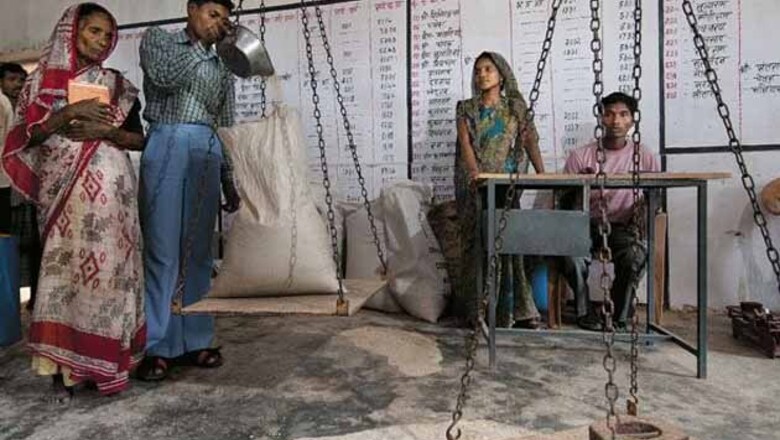
views
Probably the only thing extraordinary about Manglu is that he is the perfect example of an ordinary tribal.The 60-year-old belongs to the Pahadi Korba tribe and lives in Govindpur village of Sarguja district of Chhattisgarh.
He best represents what modern India calls a below poverty line (BPL) beneficiary of various government schemes.Manglu earns just about Rs. 200 a month and has a family of four to support.
He is uneducated, unskilled and most of all, unaware that he is eligible for some relief from the government.In the past, he would routinely rush to the village moneylender by the middle of the month to get a loan just to ward off hunger.
The repayment of this loan would then account for the bulk of his next month’s income.But lately things have changed. For the first time in his life, in August 2007,he was given a “red” card which meant that the Chhattisgarh government recognised him as one of the poorest of the poor in the state and promised to provide 35 kg of rice a month at Rs. 1 per kg under
the Public Distribution System (PDS).
Moreover, the PDS shop is now being run by his village’s Panchayat and is just walking distance from his hut.
Winds of Change
Manglu is not the only one who is hugely relieved at the manner in which the Raman Singh-led Bharatiya Janta Party (BJP) government in the state has taken up PDS reform since early 2007. Apart from increasing the coverage of PDS from the central government mandated figure of 42 percent (which translates to 19 lakh BPL households) to 74 percent (over 36 lakh households), what stands out in Chhattisgarh is the wide range of structural and legal reforms over the last six years to fix PDS.
At a time when many experts feel that PDS should be replaced with food coupons
or direct cash transfers, the Chhattisgarh model offers some key lessons on making this system work.
PDS was first started in urban India in the late 1960s in response to the critical food shortages. During the 1970s and 1980s, PDS was expanded to rural areas.
Until 1992, PDS remained a general entitlement scheme for all citizens. However, with the growing poor population, it was progressively converted into a targeted programme restricted to the BPL population by 1997. But PDS has, over time, come to be severely criticised for widespread corruption and leakages.
The situation was not very different in Chhattisgarh when Raman Singh took over as Chief Minister in 2003.
“Any village I went to, the main complaint was about the non-availability of food grains in PDS shops.I found that more than 50 percent of the rice meant for the poor would actually never reach the beneficiaries,” says Singh.
“It was clear to me that PDS had to be reformed if the people are to get their due.”
Round One of Reforms
Raman Singh began reforming the public delivery of food grains in 2004 when
he took away the ownership of all the PDS shops from private businessmen and gave it to local community-owned bodies like forest co-operatives employing tribals, gram panchayats (village councils)and women self-help groups.
In the past, as is the case even today in many other states, a businessman
running the PDS shop in the village did not live in that village and had little incentive to keep the shop open on all days of the month. There was no way the local community could exercise any control over him since he was not accountable to the villagers.
“I asked the villagers whom did they trust for the delivery of food grains
and these were the institutions they mentioned. And it made sense because these
ensured collective responsibility,” says Singh.
However, the move did not go down well with the existing shop owners and it was only in September 2005 that the High Court gave its approval to the move by dismissing more than 400 petitions lodged against the government.
The second big reform came when Singh raised the commission to PDS shop
owners from Rs. 8 per quintal to Rs. 35 per quintal. Singh and his advisors knew too well that a typical PDS shop runs into losses, and that’s what motivates people to cheat and re-send food grains to the rice millers who would then sell it back to the state government at the market rate.
The state government also decided to provide interest-free loans up to Rs. 75,000 to each PDS shop as seed capital to develop the shop and tide over immediate cash flow problems.
While the move had a salutary effect on the morale of the shopkeepers, Singh’s government had to shell out an extra Rs. 80 crore per year to subsidise the move.
The Trigger for Round Two
However, the real trigger for an all out effort to reform PDS came in early 2007 when the ruling BJP lost a crucial bye-election in the Kota constituency to the Congress. PDS’s lack of performance had become a huge issue in the run up to the polls, with the former chief minister, Congressman Ajit Jogi, criticising Singh’s efforts at reform.
The loss of this prestigious election made Singh realise the electoral potential of reforming PDS and he promised to set the system right before the State Assembly election in 2008.
Within 10 days of the loss in Kota, Singh put together a crack team of bureaucrats led by the then State Chief Electoral Officer Alok Shukla, who was given the additional charge of the Food Department.
“According to me, if somebody wanted to get elected based on better governance then there is nothing wrong about it. The CM assured us that there will be no political interference if we took on the vested interests,” says Shukla, who is now a deputy election commissioner in New Delhi.
The Strategy
The team led by Shukla as the Food Secretary quickly went through with informal discussions with all stakeholders and came to the conclusion that merely focussing on PDS shops or the last mile of delivery is not enough to ensure
corruption-free services. So they drew up an ambitious reform plan which involved manifold increase in the level of subsidy to over Rs. 700 crore and targeted many of the power centres in the state.
“We realised that the key to plug the leakages was to stop the recycling of paddy done by the rice millers of the state in connivance with the government officials,” says Shukla.
Typically, the rice which was transported from the government warehouse to the PDS shop was diverted to the rice millers, who sold it back to the government as fresh rice. This way, the same rice was sold many times over, with the scam running into crores of rupees. Bolstered by the confidence given to them by the Chief Minister,Shukla’s team went after the culprits in the following months.
“We conducted numerous raids and seized large quantities of paddy and rice. We arrested over 200 people, many of whom did not get bail for over 6 months and all this happened without any political interference,” says Shukla.
The other big cause of concern was the prevalence of bogus BPL cards. This meant the diversion of subsidised food grains to ineligible users — often the food grains would find its way to the open market. It also meant a huge exclusion of deserving candidates, since the state could not provide BPL cards to more than the number of poor mandated by the central government. To take care of the bogus cards, Raman Singh gave a go ahead to fresh centralised printing of BPL cards based on a new database — close to 3 lakh bogus cards were weeded out.
Singh also increased the number of families covered under PDS. Apart from including all the households which were part of the BPL in the past, the new regime provided automatic inclusion to the weakest sections of the society.
These included the old and the destitute, the disabled and the Primary
Tribal Groups like the Pahadi Korba to which Manglu belongs. The price was reduced to Rs. 1 per kg for the poorest of the poor.
The third big reform was in the monitoring system.
“Bulk of the pilferage used to happen before the grains reached the PDS shops. To plug the leakages, the first step was to take away the transportation of grains out of the private players’ [hands].
This was now done through the civil supplies corporation so as to ensure better accountability of the food grains,” says Singh. The government ensured that the grains reached every PDS shop by the 6th of each month.
A Web-based application tracked the trucks dispatched as well as the amount of food grains that were being procured, transported, and received at different
points of the journey. All this was placed on the Web and circulated through an SMS to whoever wished to be kept in the loop.
The 7th of each month was designated as “Chawal Utsav” or Rice Festival, where people could come and pick up their monthly stock in the presence of all government and vigilance officers and elected local representatives. The move brought about awareness among the people and infused transparency in the whole system.
Results
Today Chhattisgarh is considered one of the best performing states in terms of PDS; a far cry from the apathy that resulted in numerous starvation deaths in 1992 and forced the incumbent Prime Minister, P.V. Narasimha Rao, to visit Sarguja.
“Chhattisgarh has set out a model for the entire country on creating a vibrant PDS by linking it to the procurement of paddy and efficient management of the supply chain,” says Biraj Patnaik, an advisor to the Supreme Court Food Commissioners, who have been involved in guiding the contours of the PDS reforms in the state. “Today we spend over Rs. 1,000 crore on PDS. Many people told me that this was a waste but in my view it is the best use of money,” says Singh.
Not surprisingly, Singh was voted back to power in the 2008 state assembly elections. Even in the 2009 Lok Sabha elections, BJP won 10 of the 11 seats from
the state.
Sunil Kumar, a veteran journalist and editor of Chhattisgarh magazine in Raipur, marvels at the political foresight of the move: “Look at it this way. Even at Rs. 1,000-odd crore he [Raman Singh] is spending just 5 percent-odd
of his overall state budget and yet benefiting nearly 65 percent to 70 percent of his electorate. It makes a lot of political sense.”
Can Other States Do It?
So why haven’t other states done the same?
Non-availability of adequate resources, and a lack of political will and leadership are the big reasons. Chhattisgarh is a budget surplus state. It also has enough food grains to feed its people.
“It is not easy for relatively poorer states like Bihar to replicate the model since it requires a fair amount of resources to be dedicated to it,” says Himanshu, economics professor at the Jawaharlal Nehru University.
What allowed Raman Singh to achieve these reforms was the fact that he was politically astute to avoid disturbing the existing beneficiaries.That is where other states have failed.“Chhattisgarh focussed on ensuring that all deserving candidates are covered under the scheme and while it cancelled the bogus cards, yet it did not strike out the names of many people who may not be just as poor,” says Himanshu.
In many ways Chhattisgarh is well on its way to becoming like Tamil Nadu, which continues to give top priority to PDS irrespective of the change in governments.
The Way Forward for Chhattisgarh
However, many observers feel that while Chhattisgarh reformed the existing system, it has not yet solved the issue completely.
“The key issue is targeting. It is that which leads to corruption. Chhattisgarh has circumvented that issue by expanding the coverage of the programme,” says Himanshu. Patnaik agrees. “Reforms have allowed the state to track the movement of food grains up to the shop. But there is no system yet which authenticates whether the food grains are being collected by the household. This last mile authentication is imperative not just to further curb leakages but also to make the entitlement of food grains ‘portable’ instead of being fixed to a particular ration shop.”
It is perhaps here that the Unique Identity Card scheme will come in handy, when it is completed in 2014.The card will ensure that bogus demand is automatically turned down — for example, in cases where one person hold
more than one BPL card. UID cards will also allow people to get their grains from any shop. This could be useful for migrant labourers.




















Comments
0 comment